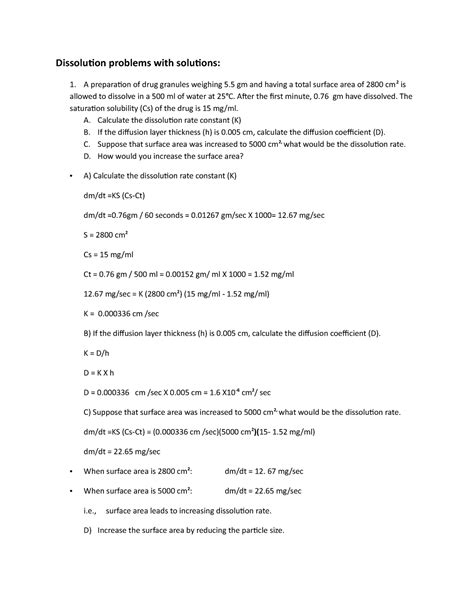Understanding the Degree of Dissolution
The degree of dissolution is a quantitative measure that describes the extent to which a solute dissolves in a solvent. It is expressed as the ratio of the mass of the solute that dissolves to the total mass of the solution. The degree of dissolution is an important concept in chemistry and has applications in various fields, including pharmaceutical, food, and environmental sciences.

Key Terms
- Solute: The substance that dissolves.
- Solvent: The substance in which the solute dissolves.
- Solution: A homogeneous mixture of a solute and a solvent.
- Saturation: The state where a solution contains the maximum amount of solute that can dissolve at a given temperature and pressure.
- Supersaturation: A state where a solution contains more solute than it can normally dissolve at a given temperature and pressure.
Factors Affecting the Degree of Dissolution
The degree of dissolution is influenced by several factors, including:
- Temperature: Generally, the degree of dissolution increases with temperature. Higher temperatures provide more kinetic energy to the solute molecules, allowing them to overcome intermolecular forces and dissolve more easily.
- Surface area: The larger the surface area of the solute, the faster it dissolves. Increasing the surface area allows for more solute molecules to come into contact with the solvent molecules.
- Agitation: Stirring or shaking a solution can increase the degree of dissolution by promoting contact between the solute and solvent molecules.
- Solvent polarity: Polar solvents dissolve polar solutes better than nonpolar solvents. Conversely, nonpolar solvents dissolve nonpolar solutes better than polar solvents.
- Chemical composition of the solute and solvent: The chemical nature of the solute and solvent also affects the degree of dissolution. Solutes with similar chemical structures often show higher degrees of dissolution.
Applications of Degree of Dissolution
The degree of dissolution has numerous applications across various fields:
- Pharmaceutical industry: The degree of dissolution is crucial for determining the bioavailability of drugs. It affects the rate and extent of drug absorption into the body.
- Food industry: The degree of dissolution influences the flavor, texture, and stability of food products. It plays a role in the development of new food formulations and the optimization of existing products.
- Environmental science: The degree of dissolution is important for understanding the fate and transport of pollutants in the environment. It helps assess the solubility and mobility of contaminants in soil and water systems.
Practice Problems
Problem 1
A solution contains 10 grams of sodium chloride (NaCl) dissolved in 100 grams of water. Calculate the degree of dissolution of NaCl in this solution.
Solution:
Degree of dissolution = (Mass of NaCl dissolved / Total mass of solution) * 100%
= (10 g / 110 g) * 100%
= 9.09%
Problem 2
A saturated solution of potassium nitrate (KNO3) at 25°C contains 45 grams of KNO3 per 100 grams of water. What is the approximate degree of dissolution of KNO3 in this solution?
Solution:
The saturated solution represents the maximum degree of dissolution at given conditions. Therefore, the degree of dissolution is approximately:
= (45 g / 145 g) * 100%
= 31.03%
Problem 3
A solution containing 0.1 moles of sucrose (C12H22O11) in 1 liter of water has a volume of 1.01 liters. What is the degree of dissolution of sucrose in this solution?
Solution:
Mass of sucrose = 0.1 moles * 342 g/mole = 34.2 grams
Total mass of solution = 1.01 kg = 1010 grams
Degree of dissolution = (34.2 g / 1010 g) * 100%
= 3.38%
Problem 4
A solution of calcium carbonate (CaCO3) in water has a degree of dissolution of 0.001%. Calculate the mass of CaCO3 dissolved in 200 grams of this solution.
Solution:
Mass of CaCO3 dissolved = Degree of dissolution * Total mass of solution
= 0.001% * 200 g = 0.002 grams
Conclusion
The degree of dissolution is a fundamental concept in chemistry with wide-ranging applications. Understanding and manipulating the factors that affect the degree of dissolution are essential for optimizing processes in various fields, from pharmaceutical research to environmental monitoring. By solving practice problems, students can gain a deeper understanding of this important concept and develop their problem-solving skills.
